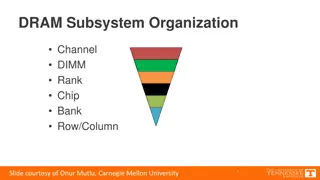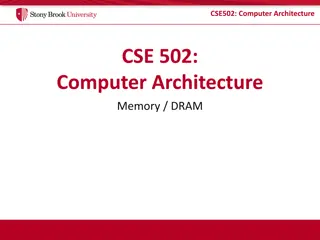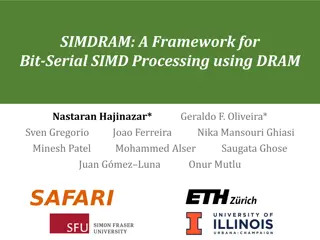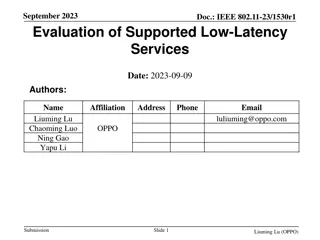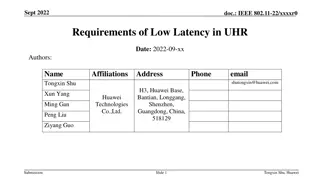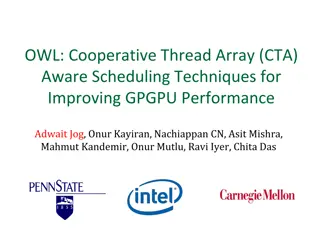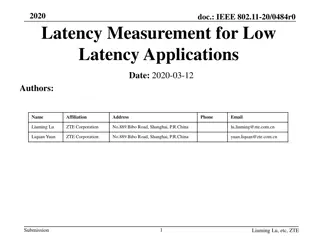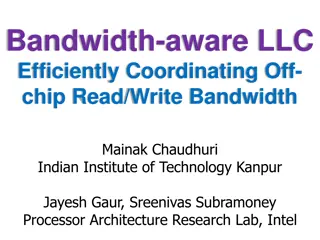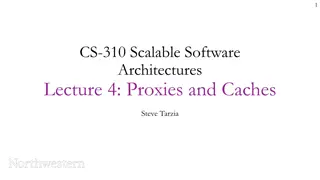Architecting DRAM Caches for Low Latency and High Bandwidth
Addressing fundamental latency trade-offs in designing DRAM caches involves considerations such as memory stacking for improved latency and bandwidth, organizing large caches at cache-line granularity to minimize wasted space, and optimizing cache designs to reduce access latency. Challenges include managing tag stores efficiently, reducing latency in DRAM cache approaches, and reevaluating cache optimizations to enhance DRAM cache performance.
Download Presentation

Please find below an Image/Link to download the presentation.
The content on the website is provided AS IS for your information and personal use only. It may not be sold, licensed, or shared on other websites without obtaining consent from the author. Download presentation by click this link. If you encounter any issues during the download, it is possible that the publisher has removed the file from their server.
E N D
Presentation Transcript
Fundamental Latency Trade-offs in Architecting DRAM Caches Moinuddin K. Qureshi ECE, Georgia Tech Gabriel H. Loh, AMD MICRO 2012
3-D Memory Stacking 3D Stacking for low latency and high bandwidth memory system - E.g. Half the latency, 8x the bandwidth [Loh&Hill, MICRO 11] Source: Loh and Hill MICRO 11 Stacked DRAM: Few hundred MB, not enough for main memory Hardware-managed cache is desirable: Transparent to software 3-D Stacked memory can provide large caches at high bandwidth
Problems in Architecting Large Caches Organizing at cache line granularity (64 B) reduces wasted space and wasted bandwidth Problem: Cache of hundreds of MB needs tag-store of tens of MB E.g. 256MB DRAM cache needs ~20MB tag store (5 bytes/line) Option 1: SRAM Tags Option 2: Tags in DRAM Fast, But Impractical (Not enough transistors) Na ve design has 2x latency (One access each for tag, data) Architecting tag-store for low-latency and low-storage is challenging
Loh-Hill Cache Design [Micro11, TopPicks] Recent work tries to reduce latency of Tags-in-DRAM approach 2KB row buffer = 32 cache lines Data lines (29-ways) Tags Miss Map Cache organization: A 29-way set-associative DRAM (in 2KB row) Keep Tag and Data in same DRAM row (tag-store & data store) Data access guaranteed row-buffer hit (Latency ~1.5x instead of 2x) Speed-up cache miss detection: A MissMap (2MB) in L3 tracks lines of pages resident in DRAM cache LH-Cache design similar to traditional set-associative cache
Cache Optimizations Considered Harmful DRAM caches are slow Don t make them slower Many seemingly-indispensable and well-understood design choices degrade performance of DRAM cache: Serial tag and data access High associativity Replacement update Optimizations effective only in certain parameters/constraints Parameters/constraints of DRAM cache quite different from SRAM E.g. Placing one set in entire DRAM row Row buffer hit rate 0% Need to revisit DRAM cache structure given widely different constraints
Outline Introduction & Background Insight: Optimize First for Latency Proposal: Alloy Cache Memory Access Prediction Summary
Simple Example: Fast Cache (Typical) Consider a system with cache: hit latency 0.1 miss latency: 1 Base Hit Rate: 50% (base average latency: 0.55) Opt A removes 40% misses (hit-rate:70%), increases hit latency by 40% Opt-A Base Cache Break Even Hit-Rate=52% Hit-Rate A=70% Optimizing for hit-rate (at expense of hit latency) is effective
Simple Example: Slow Cache (DRAM) Consider a system with cache: hit latency 0.5 miss latency: 1 Base Hit Rate: 50% (base average latency: 0.75) Opt A removes 40% misses (hit-rate:70%), increases hit latency by 40% Break Even Hit-Rate=83% Opt-A Base Cache Hit-Rate A=70% Optimizations that increase hit latency start becoming ineffective
Overview of Different Designs For DRAM caches, critical to optimize first for latency, then hit-rate Our Goal: Outperform SRAM-Tags with a simple and practical design
What is the Hit Latency Impact? Consider Isolated accesses: X always gives row buffer hit, Y needs an row activation Both SRAM-Tag and LH-Cache have much higher latency ineffective
How about Bandwidth? For each hit, LH-Cache transfers: 3 lines of tags (3x64=192 bytes) 1 line for data (64 bytes) Replacement update (16 bytes) Configuration Raw Transfer Size on Hit Effective Bandwidth Bandwidth Main Memory 1x 64B 1x DRAM$(SRAM-Tag) 8x 64B 8x DRAM$(LH-Cache) 8x 256B+16B 1.8x DRAM$(IDEAL) 8x 64B 8x LH-Cache reduces effective DRAM cache bandwidth by > 4x
Performance Potential 8-core system with 8MB shared L3 cache at 24 cycles DRAM Cache: 256MB (Shared), latency 2x lower than off-chip LH-Cache SRAM-Tag IDEAL-Latency Optimized 1.8 Speedup(No DRAM$) 1.6 1.4 1.2 1 0.8 0.6 LH-Cache gives 8.7%, SRAM-Tag 24%, latency-optimized design 38%
De-optimizing for Performance LH-Cache uses LRU/DIP needs update, uses bandwidth LH-Cache can be configured as direct map row buffer hits Configuration Speedup Hit-Rate Hit-Latency (cycles) LH-Cache 8.7% 55.2% 107 LH-Cache + Random Repl. 10.2% 51.5% 98 LH-Cache (Direct Map) 15.2% 49.0% 82 IDEAL-LO (Direct Map) 38.4% 48.2% 35 More benefits from optimizing for hit-latency than for hit-rate
Outline Introduction & Background Insight: Optimize First for Latency Proposal: Alloy Cache Memory Access Prediction Summary
Alloy Cache: Avoid Tag Serialization No need for separate Tag-store and Data-Store Alloy Tag+Data One Tag+Data No dependent access for Tag and Data Avoids Tag serialization Consecutive lines in same DRAM row High row buffer hit-rate Alloy Cache has low latency and uses less bandwidth
Performance of Alloy Cache Alloy+MissMap Alloy+PerfectPred SRAM-Tag Alloy Cache 1.8 Speedup(No DRAM$) 1.6 1.4 1.2 1 0.8 0.6 Alloy Cache with no early-miss detection gets 22%, close to SRAM-Tag Alloy Cache with good predictor can outperform SRAM-Tag
Outline Introduction & Background Insight: Optimize First for Latency Proposal: Alloy Cache Memory Access Prediction Summary
Cache Access Models Serial Access Model (SAM) and Parallel Access Model (PAM) Higher Miss Latency Needs less BW Lower Miss Latency Needs more BW Each model has distinct advantage: lower latency or lower BW usage
To Wait or Not to Wait? Dynamic Access Model: Best of both SAM and PAM When line likely to be present in cache use SAM, else use PAM Prediction = Cache Hit Use SAM L3-miss Address Memory Access Predictor (MAP) Prediction = Memory Access Use PAM Using Dynamic Access Model (DAM), we can get best latency and BW
Memory Access Predictor (MAP) We can use Hit Rate as proxy for MAP: High hit-rate SAM, low PAM Accuracy improved with History-Based prediction 1. History-Based Global MAP (MAP-G) Single saturating counter per-core (3-bit) Increment on cache hit, decrement on miss MSB indicates SAM or PAM Table Of Counters (3-bit) 2. Instruction Based MAP (MAP-PC) Have a table of saturating counter Index table based on miss-causing PC Table of 256 entries sufficient (96 bytes) Miss PC MAC Proposed MAP designs simple and low latency
Predictor Performance Accuracy of MAP-Global: 82% Accuracy of MAP-PC: 94% Alloy+NoPred Alloy+MAP-Global Alloy +MAP-PC Alloy+PerfectMAP 1.8 Speedup(No DRAM$) 1.6 1.4 1.2 1 0.8 0.6 Alloy Cache with MAP-PC gets 35%, Perfect MAP gets 36.5% Simple Memory Access Predictors obtain almost all potential gains
Hit-Latency versus Hit-Rate DRAM Cache Hit Latency Latency LH-Cache SRAM-Tag Alloy Cache Average Latency (cycles) 107 67 43 Relative Latency 2.5x 1.5x 1.0x DRAM Cache Hit Rate Cache Size LH-Cache (29-way) Alloy Cache (1-way) Delta Hit-Rate 256MB 55.2% 48.2% 7% 512MB 59.6% 55.2% 4.4% 1GB 62.6% 59.1% 2.5% Alloy Cache reduces hit latency greatly at small loss of hit-rate
Outline Introduction & Background Insight: Optimize First for Latency Proposal: Alloy Cache Memory Access Prediction Summary
Summary DRAM Caches are slow, don t make them slower Previous research: DRAM cache architected similar to SRAM cache Insight: Optimize DRAM cache first for latency, then hit-rate Latency optimized Alloy Cache avoids tag serialization Memory Access Predictor: simple, low latency, yet highly effective Alloy Cache + MAP outperforms SRAM-Tags (35% vs. 24%) Calls for new ways to manage DRAM cache space and bandwidth
Acknowledgement: Work on Memory Access Prediction done while at IBM Research. (Patent application filed Feb 2010, published Aug 2011) Questions
Potential for Improvement Design Performance Improvement Alloy Cache + MAP-PC 35.0% Alloy Cache + Perfect Predictor IDEAL-LO Cache 36.6% 38.4% IDEAL-LO + No Tag Overhead 41.0%
Size Analysis LH-Cache + MissMap SRAM-Tags Alloy Cache + MAP-PC 1.50 Speedup(No DRAM$) 1.40 1.30 1.20 1.10 1.00 64MB 128MB 256MB 512MB 1GB Proposed design provides 1.5x the benefit of SRAM-Tags (LH-Cache provides about one-third the benefit) Simple Latency-Optimized design outperforms Impractical SRAM-Tags!
How about Commercial Workloads? Data averaged over 7 commercial workloads Cache Size Hit-Rate (1-way) Hit-Rate (32-way) Hit-Rate Delta 256MB 53.0% 60.3% 7.3% 512MB 58.6% 63.6% 5.0% 1GB 62.1% 65.1% 3.0%
Prediction Accuracy of MAP MAP-PC
LH-Cache Addendum: Revised Results http://research.cs.wisc.edu/multifacet/papers/micro11_missmap_addendum.pdf


